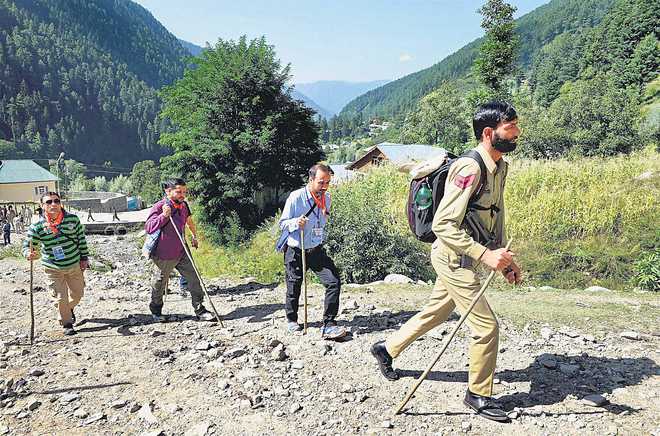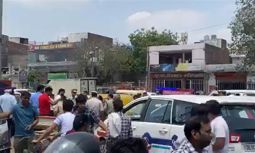
Lower terrorist strength has made cops and soldiers on leave susceptible to being targeted.
Lt-Gen Syed Ata Hasnain (retd)
IT is not the first time that a lone Kashmiri policeman or soldier has been abducted and killed. Javed Ahmad Dar is the umpteenth policeman who while off duty has been isolated and targeted, once again in notorious Shopian. A number of Army soldiers have similarly been targeted when off duty, on leave and outside the organised support of their units; the recent case of rifleman Aurangzeb is too well known to reiterate. This includes Lt Umar Farooq of 2 Raj Rif who was killed in Kulgam last year, first among the officer cadre. All over India the public is understandably frustrated at the loss of these Kashmiri bravehearts with whose plight there is tremendous empathy. To comprehend the limitations in securing the men in uniform and whether anything is deficient in our ways it is important to get a measure of the working environment of security personnel in Kashmir. There are domains to examine — first the functional on-duty aspect and second the off duty challenges, or on leave.
The Army functions as units. Thus if a Jammu & Kashmir Light Infantry (JAK LI) unit consisting 50 per cent Kashmiri Muslims is deployed on either the LoC or the hinterland, the functioning is all in sub-units of at least seven men (reduced section strength); they could be deployed as just a buddy pair of two men but under constant watch and control of another superior. The hallmark of normal functioning in the Army is that no deployment can ever be in less than a buddy pair. The system of buddies ensures that even if one is resting the other is alert. Mutual support is a basic principle on which most training and execution depends. Terrorist abduction of a soldier on duty is next to impossible, although there has been one stray case in an operation near Sopore.
Vulnerability to ambushes is high in the case of small parties as quick reaction teams protect officers, logistics elements or simply isolated moves such as the ambush of the Rashtriya Rifles group in 2013 near Hyderpura on the national highway, in which we lost eight bravehearts. The element of vulnerability is the highest among the Army’s Territorial Army (Home and Hearth) units in which the composition of personnel is largely local and the units stay within the Valley. The frequency of home visits by personnel is higher, making them much more vulnerable.
The Army’s role and system of functioning obviously differs from the J & K Police (JKP), where the personnel are fully secure as they are deployed as armed police units. The Special Operations Group (SOG) also work in small teams but not so small as to be isolated and targeted. For the conduct of operations beyond intelligence gathering they work in close concert with Army units which give them inherent security.
The vulnerability is the highest of the Station House Officers (SHOs) and their staff at police stations which is not so numerous as to afford the required overkill for ensured security. SHO Feroz Dar of Anantnag was killed a year ago in an ambush along with six of his men. The thing to remember about vulnerability of policemen is that armed police units live mostly in police lines but personnel manning police stations often live among the people and many times in their own homes. Under normal circumstances that is the best way of policing with local policemen in the know of everything in and around their abodes. However, with terror threats that makes these policemen most vulnerable.
All personnel on leave have to visit their homes. In earlier periods of higher terrorist presence even notorious tehsils such as Tral had an unwritten code and security men on leave were usually not targeted even if alone or in their homes. It is with lower terrorist strength that abduction, torture, uploading of videos and eventual killing has become a norm. These personnel are the softest targets, mostly unarmed and their killing has a high impact on social media and national media. Foreign terror groups looking for reporting back to proxy masters count these as achievements. What is surprising is local groups resorting to this as it draws the ire of the public. It appears to indicate the absence of mature leadership directing the local terror operations. This is the sentiment on which the JKP has not sufficiently focused in terms of psychological exploitation painting the local terrorists as villains among their own people. Naming and shaming them in the local environment places the pressure of ethics on local terrorists (LTs), the lack of which robs a local family off its bread earner.
How else can personnel travelling on leave and inevitably going home alone be better secured? The Army has an SOP of personnel reporting to the nearest posts but this affords only token security. There have been proposals to allow local security personnel to carry their service weapons while on leave. For many reasons, including that of potential desertion and snatching, this is not a doable idea. Providing additional manpower for personal security to all is out of the question, resource wise. Buddy pair system for policemen is possible up to a point and definitely not on leave. The far better way perhaps is to rouse the conscience of the people but the establishment has generally been weak at this, its so-called outreach has been undefined and unimaginative; social media can be better harnessed through professional advice. A suggestion of collective social and economic retribution against villages which cannot protect their own policemen or soldiers is never a good idea as it has many negative spin-offs.
The enthusiastic response to recruitment opportunities for entry into the various security-related organisations is equally balanced by the huge turnout at funerals of terrorists. This is the paradox of Kashmir which needs greater ground-based research by some advanced research institutions because top of the head deductions will not assist in curbing the threat to those who do service for the nation. As a starter, the identity of known perpetrators of such criminal acts must be projected all over the general area from where the LTs hail. If funerals of LTs can give rise to passions among the youth to join the LT ranks, surely the sentiments on the targeted killing of local isolated security personnel can also be similarly exploited.
Former GOC of the Srinagar-based 15 Corps



























